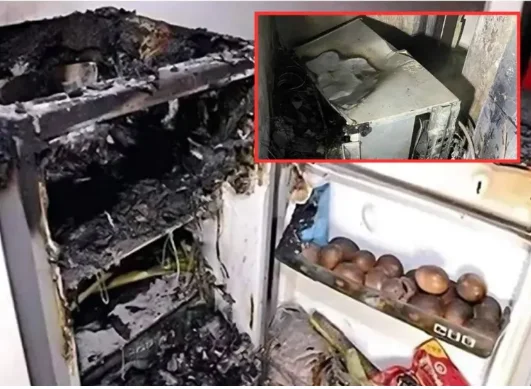6 Refrigerator Mistakes That Could Put Your Home at Risk
Refrigerators are vital household appliances, but if not used or maintained correctly, they can become a source of serious safety hazards. From fire risks to explosions, improper refrigerator practices can endanger your home and family. Below are six dangerous refrigerator mistakes people commonly make—and how to avoid them.
1. Positioning the Refrigerator Near Heat Sources
Placing your refrigerator next to heat-generating appliances like stoves, ovens, or microwaves can increase the risk of overheating and even explosion. The heat forces the fridge to work harder, potentially causing malfunctions.
Additionally, avoid positioning power cords near flammable materials like curtains or blankets, as a short circuit could ignite a fire that spreads rapidly.
2. Keeping an Old or Poorly Maintained Refrigerator
Outdated or neglected refrigerators can become a safety hazard over time. Problems like clogged capillary tubes or worn-out components may lead to pressure buildup, reduced cooling efficiency, and even accidents.
Warning signs your refrigerator needs attention:
- The compressor runs nonstop.
- Loud or unusual noises during operation.
- Excessive ice buildup.
- Insufficient cooling performance.
To prevent problems, schedule regular maintenance and replace old refrigerators before they become unsafe.

3. Freezing Carbonated Drinks or Alcohol
It’s tempting to chill a drink quickly in the freezer, but placing carbonated beverages or alcohol there can lead to dangerous explosions. The pressurized liquid reacts poorly to freezing temperatures, causing bottles or cans to burst.
Similarly, avoid freezing liquids in glass containers, as water expands when frozen and can shatter the glass, posing a risk of injury.
4. Ignoring Gas Leaks or Electrical Hazards
Refrigerator gas tanks are built to last, but damage to welds or pipes can cause leaks. When combined with an electrical spark, these leaks could result in an explosion.
Additionally, overloading your electrical circuits with high-power appliances (like air conditioners) alongside the refrigerator increases the chances of short circuits and fires.
5. Overloading Electrical Outlets
Refrigerators require a dedicated power outlet to operate safely. Sharing the outlet with other devices can overload the circuit, increasing the risk of a short circuit or fire. For added safety, avoid using extension cords or power strips with your refrigerator.
6. Using Chemicals Near the Refrigerator
Using insect repellents, hairsprays, or other flammable chemicals near your refrigerator can be extremely dangerous. Even a small spark from the appliance could ignite these chemicals, leading to a potential explosion.
Conclusion
Preventing refrigerator-related accidents is simple with proper care and precautions. Regular maintenance, thoughtful placement, and attention to potential hazards like electrical connections or flammable materials can go a long way in keeping your home safe. Protect your household by avoiding these common mistakes.
I Found My Late Husband’s Old Wristwatch in My Second Husband’s Nightstand Drawer

When Angela stumbles upon her late husband’s wristwatch inside her second husband Bryan’s nightstand drawer, her world shatters. She confronts Bryan, but his answers reveal a devastating truth that tears her life apart.
I don’t know how to begin, but maybe it’s best if I just tell it as it happened. There are days that start out ordinary, and then, in the blink of an eye, everything changes. This was one of those days.

A thoughtful woman | Source: Midjourney
I was tidying up the house, keeping busy, keeping my mind from wandering too much into the past. Bryan’s side of the bed was its usual mess, with socks kicked off hurriedly and his nightstand drawer slightly open.
I wasn’t snooping, I swear, but something about that open drawer caught my eye. Maybe it was just instinct, or maybe it was fate pushing me toward the truth.
When I opened it fully, I didn’t expect to find anything out of the ordinary. But then I saw it.

An open drawer | Source: Pexels
A wristwatch. And not just any wristwatch. It had belonged to my late husband Jeff. The one I gave him on our first anniversary, with the words “Forever Yours, A.” engraved on the back. My heart stopped and literally skipped a beat as I picked it up with trembling hands.
I knew that watch like I knew my heartbeat. But it shouldn’t be here. Bryan didn’t even know Jeff. I only met him six months after Jeff died. I felt a cold wave of confusion wash over me.
How could Bryan have this? It didn’t make sense. Nothing about this made sense.

A shocked woman | Source: Midjourney
I dropped the watch, my hands shaking too much to hold onto it. It fell to the carpet with a soft thud, but the noise echoed in my head like a bomb going off.
When Bryan came home that evening, I didn’t even let him take off his coat before I confronted him. My voice was tight, barely controlled, as I held up the watch in front of him.
“Where did you get this?”
The look on his face told me everything and nothing at the same time.

A man with an unreadable expression | Source: Midjourney
He went pale, eyes wide like he’d seen a ghost. He just stared at the watch, his mouth opening and closing like he couldn’t find the words. The silence stretched between us, thick and heavy, until I thought I might scream just to break it.
Finally, Bryan spoke, but his voice was so soft that I had to strain to hear him. “I… I didn’t want you to find out like this.”
“Find out what?” I snapped, my frustration bubbling over.

An angry woman | Source: Midjourney
He looked away, running a hand through his hair, his whole body tense like he was bracing for impact. “Angela, there’s something I need to tell you. Something I should have told you from the beginning, but I didn’t know how.”
I felt a chill run down my spine. “What are you talking about?”
“Jeff was… Jeff was my brother.”
I stared at him, my mind rejecting the words. It felt like someone had punched me in the stomach, and I couldn’t breathe.

A woman gasping in shock | Source: Midjourney
“Your brother? But Jeff never said he had a brother… and you never said anything either. We’ve been married three years! How could you—”
“I didn’t just not say anything, Angela. I hid it. Years ago, I changed my name, left the country, and cut all ties with my past. I was bitter, angry, and I couldn’t stand being around my family anymore. Jeff and I had a falling out. A big one. And I thought the only way to move on was to leave it all behind, including him.”
Bryan’s voice cracked, and he looked at me with such sorrow in his eyes that it made my heart ache.

A sad man | Source: Midjourney
“I didn’t know Jeff was gone until months later. By the time I came back, it was too late. He was already dead. I went to his grave, and that’s when I saw you.”
I could feel tears prickling at the corners of my eyes, but I blinked them back, refusing to let them fall. “You saw me there? At Jeff’s grave?”
Bryan nodded, his hands shaking. “Yes. I didn’t know who you were at first, but when I found out, I… I don’t know, Angela. I was drawn to you.”

A thoughtful man | Source: Midjourney
“Maybe it was guilt, or maybe it was something else, but I couldn’t stay away. And then… then we fell in love.”
I felt like the room was spinning. This man, the one I had trusted, had kept this from me? This wasn’t just some mistake; this was my entire life, everything I thought I knew, turned upside down.
“But the watch,” I managed to say, my voice shaking as much as my hands. “How did you get Jeff’s watch?”

A woman speaking to her husband | Source: Midjourney
“After I came back, I found my mother at Jeff’s grave. She forgave me, even though I didn’t deserve it. And she gave me this,” he gestured to the watch, his voice heavy with regret. “It was the only thing she had left of Jeff. A way to make peace, she said. I wanted to tell you, but I was afraid you’d hate me.”
I stood there, staring at the man I thought I knew, and I couldn’t make sense of anything anymore.

Close up of a woman’s face | Source: Midjourney
His words kept circling in my head, wrapping tighter around my heart, choking the life out of me. Jeff’s brother. How had I missed it? How could I have been so blind?
“Angela, please,” he started, taking a step closer. But I held up my hand to stop him, needing distance, needing to breathe. I couldn’t look at him without seeing all the lies, all the secrets that had been hiding in plain sight.
“I… I can’t do this,” I said, my voice sounding foreign, hollow.

A woman standing in a kitchen | Source: Midjourney
The room felt like it was closing in on me, the walls pushing in until there was no space left to think, to feel anything but the overwhelming weight of betrayal.
“Angela, listen to me,” Bryan pleaded, his voice breaking. “I know I should have told you from the beginning, but I didn’t want to lose you.”
“But you already have,” I whispered, barely able to say the words out loud. They hurt too much, like shards of glass scraping against my throat.

A heartbroken woman | Source: Midjourney
“You lost me the moment you decided to hide this from me. You let me fall in love with a lie.”
He shook his head, desperation in his eyes. “No, it wasn’t a lie. My love for you is real. Everything we’ve built together, it’s real. I swear to you, Angela, I never meant to deceive you.”
“Maybe not,” I said, my voice trembling as I fought to keep it together. “But you did. You deceived me every day you looked me in the eye and didn’t tell me the truth. I trusted you, Bryan. I trusted you with everything I had left after Jeff, and now… now I don’t even know who you are.”

A woman pointing her finger | Source: Midjourney
The silence that followed was heavy and suffocating. Bryan’s shoulders slumped, his face a mask of sorrow and regret. I could see the pain in his eyes, but it didn’t change the fact that I felt like I’d been living in someone else’s story, a story I didn’t sign up for.
I turned away from him, the tears I’d been holding back finally spilling over.
“I need to pack,” I muttered, more to myself than to him. I needed to move, to do something, anything, to keep from falling apart completely.

A woman in a darkened hallway | Source: Midjourney
“Please, Angela, don’t go,” Bryan begged, but his voice sounded distant. It was as if it was coming from the other end of a tunnel. “We can work through this. We can—”
“There’s nothing to work through,” I interrupted, choking on my own words. “I can’t stay in this marriage, Bryan. Not after this. I can’t stay with someone I don’t even recognize anymore.”
I walked to the bedroom, each step feeling heavier than the last. My hands shook as I pulled out a suitcase, the sound of the zipper echoing in the room.

A woman packing a suitcase | Source: Pexels
Bryan stood in the doorway, his face pale, watching me pack with a helplessness that almost broke me. Almost. But the anger and betrayal were stronger, driving me forward and pushing me to leave behind everything we had built.
“Angela, please,” he said one last time, his voice so soft, so broken, it was almost a whisper.
But I couldn’t stop. If I stopped, I’d crumble, and I couldn’t afford that. Not now. Not ever.

A woman hanging her head | Source: Midjourney
I zipped up the suitcase and lifted it from the bed. My heart pounded as I walked past him without a word. As I reached the front door, I hesitated, just for a moment.
Part of me wanted to turn back, to give him one last look, but I couldn’t. I knew if I did, I might lose the strength I’d gathered to walk away.
So I stepped out the door, the cool evening air hitting my face like a slap. I didn’t look back as I walked to my car and climbed in, each step feeling like I was tearing my heart out.

A woman in a car | Source: Midjourney
But I kept going because there was no other choice. The man I loved, the man I thought I knew, was a stranger. And I couldn’t live with that. Not anymore.



Leave a Reply